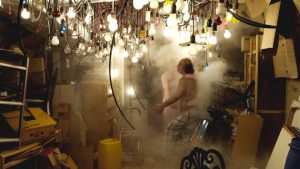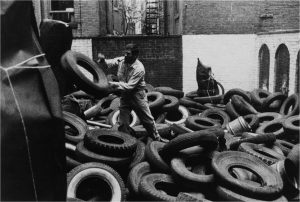PRIMARY RESEARCH
Interview with an employee from Yanji. She said she was from Malaysia and she has already worked here for 15 years. Nothing much has changed around the Old Woodlands Town Centre for these years.

Clips with different colors and numbers on it representing different dishes and table numbers for easier service.
Another interview with the cleaning auntie from Malaysia who’ve worked here for 8 years. She said most customers are residents nearby, and workers between Singapore and Malaysia.
Madam Fadzlun, 56, a shop owner selling Tupperware goods lamented that rental cost is “too expensive elsewhere”.

“We’ve gone to talk to our Member of Parliament for help on this, but nothing has been done yet. The number of walk-in customers has dropped over the years, but we can’t do anything,” she shared.

Similarly, Joanne Nyang, 50, who owns a stall selling dried goods said she has yet to find a suitable shopfront.
“When the time comes to move out, then we’ll see how it goes. I’ve stopped ordering more stocks already, just in case,” said Mdm Nyang, who’s been working here for over 30 years.

At a sprawling clothes shop just down the road, shop owner Ho Chee Kiong, 54, shared that he’ll take things as they come.
“If we’re able to bid for [a suitable] location, then we’ll bid for it. [If not], then we’ll see how [it goes],” he shrugged, adding that he has no preference for the location as long as the rent is cheap.
At the very same shop, Mr Ho, 53, who declined to give his full name, said, “It’ll be a pity to see this place go. I’ve been here for so long, from nothing, to when I eventually got married and had kids. It’s been 26 years.”
SECONDARY RESEARCH
History of WTC
In the early seventies, kampong in Woodlands were cleared as plans to develop into an industrial and residential area. By 1972, Woodlands welcomed the completion of its first 1,300 housing units. The establishment of Woodlands Town Centre followed and became the focal point for the residents and workers.

During its heydays, the Old Woodlands Town Centre was bustling with activities both for locals and the visitors from Malaysia. Retail shops selling textiles and electronic goods were popular. The hawker centre, kopitiam and prata houses were filled with people, and more
choices in food were offered with the arrivals of fast food restaurants such as Kentucky Fried Chicken and MacDonald’s.
One of the highlights of the Old Woodlands Town Centre was the intense competition among its money changers, who offered one of the best exchange rates between Singapore Dollar and Malaysia Ringgit.
The Feature of Building
With many low-rise brown mosaic-tiled buildings lined up with retail shops, the concept and design of the Old Woodlands Town Centre is similar to that of the Bukit Merah Town Centre and Bedok Town Centre. Like its cousin in the southern part of Singapore, the Old Woodlands Town Centre started to lose its shine and attraction after the mid-nineties.

Reasons for the gloom
The size of Woodlands expanded rapidly as hundreds of residential flats sprung up. In 1996, Woodlands MRT Station and its underground bus interchange opened at the Woodlands Regional Centre, which replaced the Old Woodlands Town Centre as the central hub of the new town. Three years later, the seven-storey shopping mall Causeway Point was completed.
Today

The original Woodlands Bus Interchange, established in the early eighties to serve the residents in the northern part of Singapore, was thus replaced by the one at the Woodlands Regional Centre. The old one was converted a bus terminal, providing short intra-town services for travelers between Singapore and Malaysia. The services were soon discontinued and space became a temporary parking and pick-up points for Malaysian buses ferrying the workers.

Today, the Old Woodlands Town Centre is considered part of the Marsiling Estate.

Cinema
During the peak of his business empire in 1980, departmental chain giant Lim Tow Yong opened a branch of Oriental Emporium at the Old Woodlands Town Centre. It became a paradise for many, as thousands would flock here every weekends to enjoy shopping, dining or catching a blockbuster at the Woodlands Cinema.
The Shaw Brothers-owned Woodlands Cinema was a popular choice for the residents in the north from the late eighties to early 2000s. Shaw Organisation was the first to introduce the concept of cineplexes in Singapore, offering movie-goers different types of films under one roof. With the success of Prince and Jade at Shaw Towers in 1988, Shaw Organisation began to convert their neighbourhood cinemas into cineplexes. Republic, Oriental, Changi and Woodlands were part of the conversion plan.

Like the old town centre, the popularity of Woodlands Cinema declined in the late nineties and was later outshone by the newer and more dynamic Causeway Point’s Cathay Cineplex at the Woodlands Region Centre. It finally ceased its operation in the mid-2000s and has been left vacant since then.
Today, even bright pastel paint struggle to hide mold and other signs of age on its worn façade. But it’s a place that will be fondly remembered by its residents and customers for a long time to come.
With little upgrading, the Old Woodlands Town Centre has largely retained its appearance for the past four decades. As a town center, it may have lost its appeal and in certain times, look like a deserted ghost town. But it still serves as an ideal resting point for travelers on both sides of the Causeway, or for anyone who yearns for a quiet meal in an increasingly crowded Singapore.
Food centre
 The decades-old Woodlands Town Centre is a border town for people passing through to Malaysia or to Singapore. Though it may have lost its appeal after the relocation of Woodlands Bus Interchange in 1996 but the sleepy Woodlands Centre Road Food Centre is still serving as a pit stop for travelers on both sides of causeway who yearns for a good value meal.
The decades-old Woodlands Town Centre is a border town for people passing through to Malaysia or to Singapore. Though it may have lost its appeal after the relocation of Woodlands Bus Interchange in 1996 but the sleepy Woodlands Centre Road Food Centre is still serving as a pit stop for travelers on both sides of causeway who yearns for a good value meal.
YAN JI SEAFOOD SOUP
 This stall is undoubtedly the most popular and with the longest waiting time in this food centre. I ordered a bowl of seafood soup consists of chunky pieces of hand-shaped meatballs that are made with minced pork, mushroom and dried sole fish, slices of dory fish and prawns In the addition of crayfish for $12. Their strongly flavored broth derived its flavor from the main ingredients, sun-dried Hokkaido scallops, and dried sole fish bones. The down side, they have to control portions and volume by serving only half a bowl of soup with each order and no refill is allowed. And one Braised Pork Trotter for $8.
This stall is undoubtedly the most popular and with the longest waiting time in this food centre. I ordered a bowl of seafood soup consists of chunky pieces of hand-shaped meatballs that are made with minced pork, mushroom and dried sole fish, slices of dory fish and prawns In the addition of crayfish for $12. Their strongly flavored broth derived its flavor from the main ingredients, sun-dried Hokkaido scallops, and dried sole fish bones. The down side, they have to control portions and volume by serving only half a bowl of soup with each order and no refill is allowed. And one Braised Pork Trotter for $8.
Numbers
- Built in the 1970s, the Old Woodlands Town Centre is located right next to the Woodlands Checkpoint.
- In 1980, the Woodlands Bus Interchange was established at Woodlands Centre Road
- With the completion of Blocks 1A to 6A at Woodlands Centre Road
- Masjid An-Nur, the large mosque built in 1980 which can house up to 2,800 worshippers in one session.
- The site comprises 186 shops, 6 offices, 5 eating houses and 78 hawker stalls. Eligible shop tenants will be given an exgratia payment of $60,000.
- Woodlands Regional Bus Interchange and Woodlands MRT Station that opened in 1996.
- On 25 June 2012, the Housing and Development Board announced that Blocks 1A to 6A Woodlands Centre Road were earmarked for the Selective En bloc Redevelopment Scheme (SERS). Residents from the 147 flats will relocate to the new replacement flats at Woodlands Drive 70 by 2016.

With residents and businesses moving out of the estate, the old Woodlands Town Centre’s days of glory will come to an end.
The Old Woodlands Town Centre has come a long way from its heyday.

























































